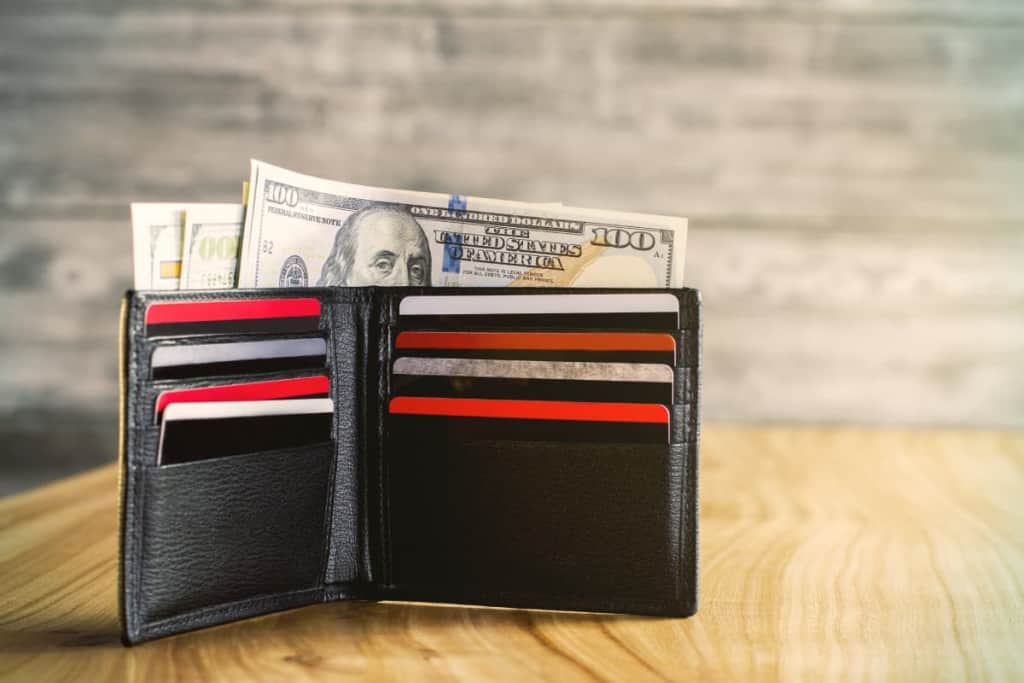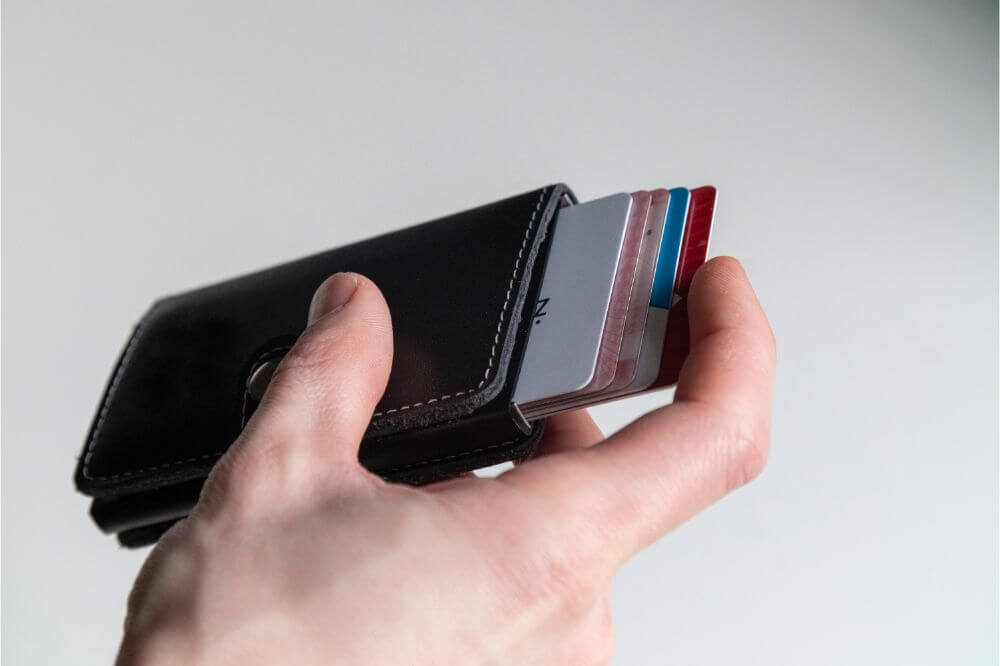We all think we know what a wallet is, but is a wallet the same thing as a billfold? Close, but not quite. Billfold vs wallet – we’ve got you covered!
Both billfolds and wallets are holders for paper money, credit cards, and other small personal items. But what’s the difference between the two?
Billfold vs Wallet
OK, first things first.
We did a quick check on Merriam-Webster. They say wallet and billfold are considered synonyms.
Hmm.
The Backstory
Let’s go back in time …
The term “wallet” goes waay back to the 14th century – when it was spelled “walet”.
The term “billfold” came about in the 1890s.
In its earliest days, a wallet was more or less a small pouch rather than what we think of today when we think of wallets. This is because, back in the 14th century, people carried metal coins rather than paper money, along with … whatever else 14th century people carried.
These days wallets are used for a lot more – paper money, coins, business cards, identification cards, credit cards, and photos.
That’s called progress, people.

Sometime in the late 19th century, the word “billfold” became popular.
Why was that?
The name came from these newfangled non-pouch wallets holding money by folding it in half (bifold wallets) or even three times (trifold wallets, natch).
Throughout the years (presumably as the novelty of having money that folded faded) the term billfold fell out of use, leaving “wallet” as the most accepted and recognized term.
So, technically the words wallet and billfold aren’t actually synonyms.
To give a quick example – a long wallet (or breast-pocket wallet) shouldn’t be considered a “billfold” because the bills are stored lengthwise, and don’t get folded as in a traditional bifold or trifold.
Sorry Merriam-Webster – we’re overruling you there.
Drum roll, please. We have our answer:
Are Wallets and Billfolds the Same?
No. Billfold is an archaic term describing a wallet that literally “folds” bills (e.g. a traditional bifold or trifold). Wallet is a broader term, so all billfolds are wallets, but not all wallets are billfolds.
Types of Wallets (and Which Can Be Considered Billfolds)
With this in mind, let’s take a look at some of the most popular types of wallets used today. Which are billfolds, and which are not?
Money Clips
The money clip has ancient origins and can be traced back to Mesopotamia. During this time, they were used by traders so they could keep their important papers in one place. You’ll also find money clips in Japanese history.
Today’s money clip originated in the US early in the 20th century. This was when paper money came into vogue, and the money clip was an excellent way to keep paper money organized. Eventually, it became a status symbol for men because it showed they had plenty of disposable income.
Verdict: Clearly not a billfold.
Bifold Wallets
The bifold wallet is probably one of the most recognizable types of wallet. It has two sections and folds down the middle. Paper money is folded once in this type of wallet, and there are usually sections for credit cards, ID, and business cards. Some bifold wallets have coin pockets.
Verdict: This is the original, the OG billfold!

Long Wallets
So, what is a long wallet? Basically, it’s a particular type of bifold wallet. It folds vertically, so the paper money isn’t folded. It also has sections for various cards and often a coin pocket.
Verdict: As we said earlier, clearly not a billfold.
Trifold Wallets
A trifold wallet has three sections that are usually equal in size. Two of the folds bring the outer sections to the center. The paper money is folded at two points, and each of the three sections will usually have slots for cards.
This type of wallet has been popular since the 1970s, when people began carrying more credit cards.
Verdict: Yes, it’s a billfold. We don’t recommend them though, as they tend to be bulky.
Checkbook Wallets
While most people use electronic banking these days, some still prefer to write checks for some things.
This type of wallet looks just like a long, bifold wallet, but it has extra space to hold a checkbook. In addition, some of these wallets also have pen holders. After all, you will need a pen if you write a check…
Verdict: Not a billfold (it’s a type of long wallet).
Travel Wallets
Most of the time, you won’t need a travel wallet, which is why it is sometimes referred to as a “secondary” wallet. However, this is an excellent option for anyone who travels internationally a lot and must carry a passport.
Most travel wallets are designed to be able to hold a passport securely, whereas standard wallets don’t have enough space for this. Of course, you can still opt to use a separate passport case, but you would end up traveling with two wallets, which is a pain.
Verdict: Usually not a billfold (typically a type of long wallet, designed around the size of a passport).
Minimalist Wallets
There are a lot of different types of minimalist wallets. One of the first to become popular was the card case (originating in the 1980s).
A minimalist wallet is usually the size of a credit or debit card, and there are card pockets on both sides in most cases. There is no section for coins, but bills are folded in half twice, so they can be neatly placed into the middle pocket.
Verdict: While not a “traditional” billfold, these modern designs do insist on bills being folded to fit, so – 21st Century Billfold!
Box Wallets

A box wallet is a card case enclosed in a sturdy frame.
This frame is typically made from carbon fiber or metal. The first aluminum wallet was designed by Ridge, and it wasn’t long before they made similar wallets from various materials, including titanium and carbon fiber.
Verdict: This is a type of minimalist wallet, typically requiring bills to be folded, so – another 21st Century Billfold!
Cellphone Wallets
This is a take on the minimalist wallet with a bit of a twist. There are two categories that cellphone wallets can fall into, those that attach to the phone and cellphone cases with wallets as an integral part.
Attachable Phone Wallets
Stick-On Cellphone Wallets
These wallets became popular and were often used as swag at conferences, trade shows, etc. Initially, an adhesive material was used to stick to the phone or the case. Newer versions have a MagSafe point that sticks the phone to the wallet via a magnet.
Detachable Cellphone Wallets
A detachable cellphone wallet is made in two parts. First, an anchor point holds the phone or the case. There is also a detachable wallet that can fit onto the anchor point. A great example is the PopSocket, which you can switch out regularly to change the look of the phone and case.
Integral Wallet/Cellphone Cases
This type of cellphone is much like a bifold but thicker. This case is made in two parts: the main cover area is for the phone, and then there is a cover that folds over the screen to protect it.
You can also carry a few cards and cash in this wallet type. Some versions are made with sections for coins. The only real drawback to this type of wallet is that if you lose it, not only have you lost your money and cards, but you have also lost your phone.
Verdict: All cellphone wallets that we’ve seen require bills to be folded to fit, so – 21st Century Billfold!
Before You Go …
OK, so there we have it.
The term “billfold” may be obsolete, but many of the popular minimalist wallet styles today assume you are carrying a few folded bills, so technically many of them could be considered “billfolds”! These wallets are all the rage, and we have the best round up of them right here – check out this article:
The (LONG!) List of The Best Minimalist Wallets!
Related Posts:
All product names, logos, brands, and trademarks are the property of their respective owners
